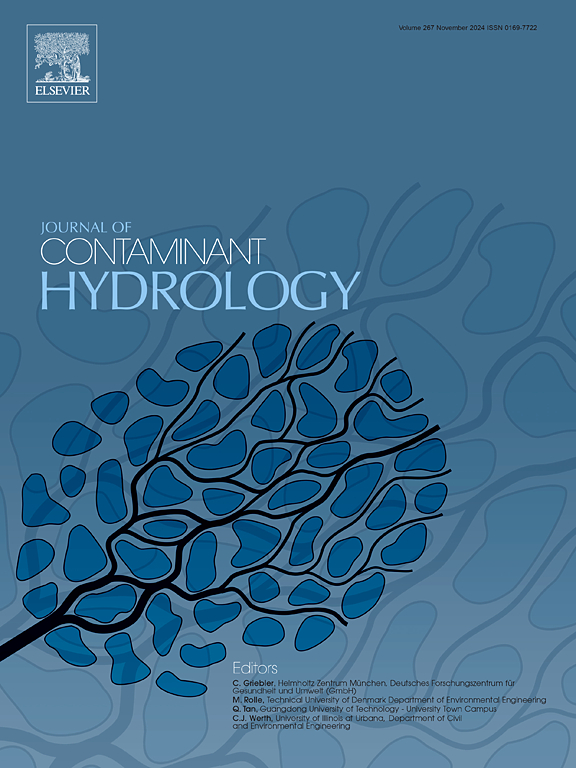Facile synthesis, characterisation and application of zinc ferrite in removal of uranium from water by adsorption
IF 3.5
3区 环境科学与生态学
Q2 ENVIRONMENTAL SCIENCES
引用次数: 0
Abstract
The present study features about the adsorption efficacy of Zinc ferrite (ZnFe₂O₄) in removing uranium from both synthetic and real groundwater samples. ZnFe₂O₄ was synthesized via the Solution Combustion Method and subsequently characterized using X-ray Diffraction (XRD), Scanning Electron Microscopy (SEM), and spectroscopic techniques, including Fourier transform Infrared (FTIR) spectroscopy and Raman spectroscopy, to assess its structural properties. The textural characteristics of the synthesized material were examined through N₂ adsorption-desorption isotherm analysis. Furthermore, X-ray photoelectron spectroscopy (XPS) and Electron spin resonance (ESR) spectroscopy were used to check and investigate the electronic states and magnetic properties of ZnFe₂O₄, respectively. Parametric batch adsorption experiments were conducted at ambient conditions by varying the uranyl (U(VI)) concentration (10–50 ppm), contact time (0–90 min), adsorbent dosage (0.1–1 g), and solution pH (3−10). The ZnFe₂O₄ nanoparticles exhibited >90 % of U (VI) adsorption at a contact time of 60 min, at pH 6, and an adsorbent dosage of 0.3 g for a 10-ppm U(VI) solution. The adsorption process was best described by the Langmuir model, with a maximum adsorption capacity of 5 mgg−1. Additionally, kinetic studies revealed a pseudo-second-order kinetic model with an equilibrium adsorption capacity of 28.68 mgg−1. The application of 0.3 g of ZnFe₂O₄ was also found to facilitate approximately 90 % U(VI) removal from groundwater samples. The ZnFe₂O₄ nanoparticles demonstrated notable adsorption efficiency and regeneration capability, sustaining performance over five consecutive adsorption-desorption cycles. These findings suggest that ZnFe₂O₄ has potential for remediation of U(VI)-contaminated water under ambient conditions.

铁酸锌吸附除铀的简易合成、表征及应用
本文研究了铁酸锌(ZnFe₂O₄)对合成和实际地下水中铀的吸附效果。采用溶液燃烧法合成了硫酸锌(ZnFe₂O₄),随后使用x射线衍射(XRD)、扫描电镜(SEM)和光谱技术(包括傅里叶变换红外(FTIR)光谱和拉曼光谱)对其进行了表征,以评估其结构性能。通过N₂吸附-解吸等温线分析考察了合成材料的结构特征。利用x射线光电子能谱(XPS)和电子自旋共振(ESR)对ZnFe₂O₄的电子态和磁性进行了表征。在环境条件下,通过改变铀酰(U(VI))浓度(10 - 50 ppm)、接触时间(0-90 min)、吸附剂用量(0.1-1 g)和溶液pH(3−10)进行参数批量吸附实验。当接触时间为60 min, pH为6,吸附剂用量为0.3 g, U(VI)浓度为10 ppm时,ZnFe₂O₄纳米颗粒对U(VI)的吸附率为90%。Langmuir模型最能描述吸附过程,最大吸附量为5 mg−1。此外,动力学研究显示了一个准二级动力学模型,其平衡吸附容量为28.68 mg−1。0.3 g硫酸锌(ZnFe₂O₄)对地下水样品的U(VI)去除率约为90%。硫酸锌纳米颗粒表现出显著的吸附效率和再生能力,在连续5个吸附-脱附循环中保持了良好的性能。这些研究结果表明,硫酸锌在环境条件下具有修复U(VI)污染水的潜力。
本文章由计算机程序翻译,如有差异,请以英文原文为准。
求助全文
约1分钟内获得全文
求助全文
来源期刊

Journal of contaminant hydrology
环境科学-地球科学综合
CiteScore
6.80
自引率
2.80%
发文量
129
审稿时长
68 days
期刊介绍:
The Journal of Contaminant Hydrology is an international journal publishing scientific articles pertaining to the contamination of subsurface water resources. Emphasis is placed on investigations of the physical, chemical, and biological processes influencing the behavior and fate of organic and inorganic contaminants in the unsaturated (vadose) and saturated (groundwater) zones, as well as at groundwater-surface water interfaces. The ecological impacts of contaminants transported both from and to aquifers are of interest. Articles on contamination of surface water only, without a link to groundwater, are out of the scope. Broad latitude is allowed in identifying contaminants of interest, and include legacy and emerging pollutants, nutrients, nanoparticles, pathogenic microorganisms (e.g., bacteria, viruses, protozoa), microplastics, and various constituents associated with energy production (e.g., methane, carbon dioxide, hydrogen sulfide).
The journal''s scope embraces a wide range of topics including: experimental investigations of contaminant sorption, diffusion, transformation, volatilization and transport in the surface and subsurface; characterization of soil and aquifer properties only as they influence contaminant behavior; development and testing of mathematical models of contaminant behaviour; innovative techniques for restoration of contaminated sites; development of new tools or techniques for monitoring the extent of soil and groundwater contamination; transformation of contaminants in the hyporheic zone; effects of contaminants traversing the hyporheic zone on surface water and groundwater ecosystems; subsurface carbon sequestration and/or turnover; and migration of fluids associated with energy production into groundwater.
 求助内容:
求助内容: 应助结果提醒方式:
应助结果提醒方式:


